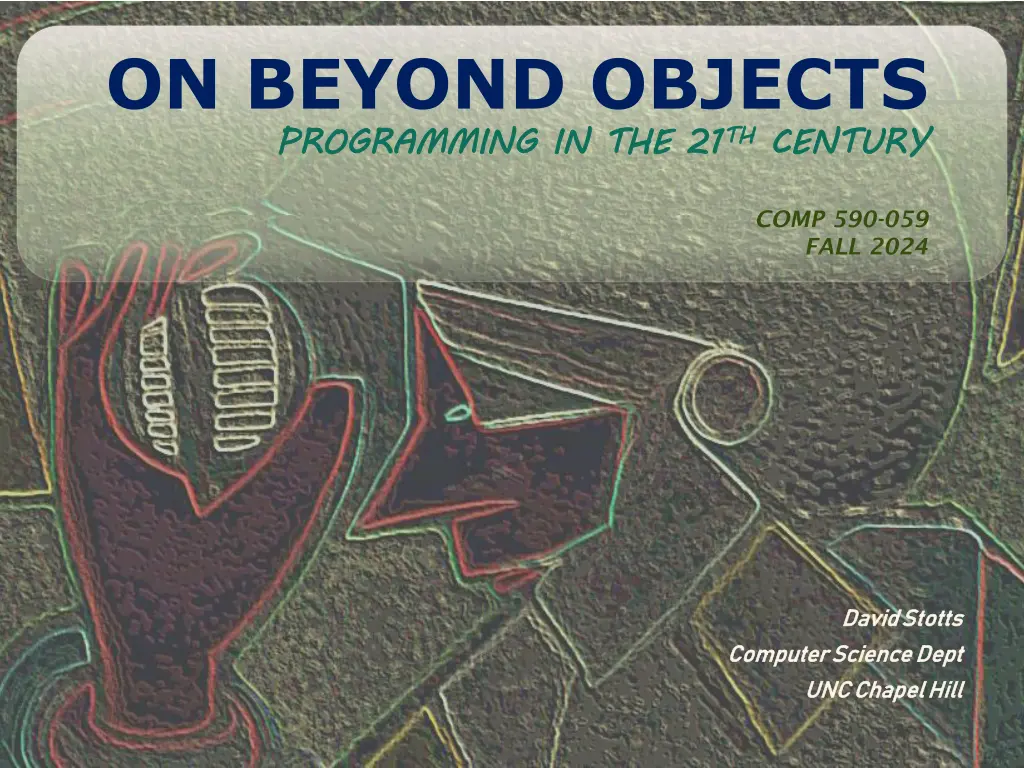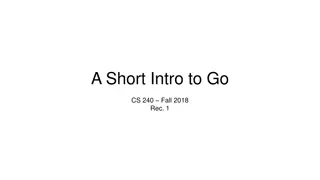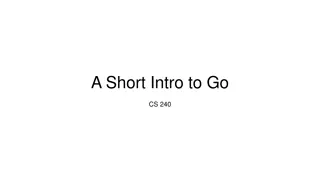
Beyond Objects: Go Language Programming
Explore the object-oriented aspects of Go programming language in the 21st century, including its unique approach to types, methods, and interfaces. Learn how Go's methods on structs provide a distinctive way of encapsulating data and behavior. Dive into the scope of variables and see examples of struct packages in action.
Download Presentation

Please find below an Image/Link to download the presentation.
The content on the website is provided AS IS for your information and personal use only. It may not be sold, licensed, or shared on other websites without obtaining consent from the author. If you encounter any issues during the download, it is possible that the publisher has removed the file from their server.
You are allowed to download the files provided on this website for personal or commercial use, subject to the condition that they are used lawfully. All files are the property of their respective owners.
The content on the website is provided AS IS for your information and personal use only. It may not be sold, licensed, or shared on other websites without obtaining consent from the author.
E N D
Presentation Transcript
ON BEYOND OBJECTS PROGRAMMING IN THE 21 PROGRAMMING IN THE 21TH THCENTURY CENTURY COMP 590-059 FALL 2024 David Stotts David Stotts Computer Science Computer Science Dept UNC Chapel Hill UNC Chapel Hill Dept
THE GO LANGUAGE OO STRUCTURE
Go Lang Is Go Object-Oriented? From the Go language FAQs: Yes and no. Although Go has types and methods and allows an object-oriented style of programming, there is no type hierarchy. The concept of interface in Go provides a different approach that the designers believe is easy to use and in some ways more general. similar to Java Interface ( some declaration differences ) There are also ways to embed types in other types to provide something analogous but not identical to subclassing. Moreover, methods in Go are more general than in C++ or Java: they can be defined for any sort of data, even built-in types such as plain, "unboxed" integers. They are not restricted to structs (classes).
Go Lang Methods on Struct Go does not provide classes or object by name It does provide structs ( like in C ) Methods can be added on structs. This provides the behavior of bundling the data and methods that operate on the data together ( partial encapsulation, akin to a class ) Function name Like a normal function declaration package main import ( "fmt" "math" ) type Vertex struct { X, Y float64 } Parameter list Return type func (v Vertex) Abs( ) float64 { return math.Sqrt(v.X*v.X + v.Y*v.Y) } This makes it a method rather than normal func and attaches it to the struct Vertex func main() { v := Vertex{3, 4} fmt.Println( v.Abs() ) } receiver
Go Lang Methods on Struct Same thing can be done with normal functions package main import ( "fmt" "math" ) type Vertex struct { X, Y float64 } func Abs(v Vertex) float64 { return math.Sqrt(v.X*v.X + v.Y*v.Y) } func main() { v := Vertex{3, 4} fmt.Println( Abs(v) ) }
Go Lang Methods on Struct Lets examine the scope of the variables package main import ( "fmt" "math" ) type Vertex struct { X, Y float64 } Caps so exported Wont matter in this demo since all code is in package main func (v Vertex) Abs() float64 { return math.Sqrt(v.X*v.X + v.Y*v.Y) } func main() { v := Vertex{3, 4} fmt.Println( v.Abs() ) } Caps so must be exported for Abs to see the data needed
Go Lang Go Objects Example of struct package with methods package main import ( "oop/employee" ) func main() { e := employee.Employee{ FirstName: "Sam", LastName: "Aders", TotalLeaves: 27, LeavesTaken: 12, } e.LeavesRemaining() } Method call on Employee struct
Go Lang Go Objects package employee import ( "fmt" ) type Employee struct { // upper E-mployee exported FirstName string // upper F-irstName so these are exported LastName string // code outside this package CAN use the TotalLeaves int // fields of the struct LeavesTaken int } Method with accepting struct func (e Employee) LeavesRemaining() { // exported fmt.Printf("%s %s has %d leaves remaining\n", e.FirstName, e.LastName, (e.TotalLeaves - e.LeavesTaken) ) }
Go Lang Go Objects Now deal with encapsulation global visibility via export The struct is not exported. Its fields are not visible outside package employee package employee import ( "fmt" ) type employee struct { // lower e-mployee means not exported firstName string // lower f-irtName so not exported lastName string totalLeaves int leavesTaken int } Since the struct is not exported, we add a method to manufacture and return one func New(firstName string, lastName string, totalLeave int, leavesTaken int) employee { e := employee {firstName, lastName, totalLeave, leavesTaken} return e } func (e employee) LeavesRemaining() { // this is exported fmt.Printf("%s %s has %d leaves remaining\n",e.firstName, e.lastName, (e.totalLeaves - e.leavesTaken)) }
Go Lang Go Objects Now deal with encapsulation global visibility via export Main, using the object cannot reach in and assign to fields of the employee struct package main Method call New in package employee struct import ( "oop2/employee" ) func main() { e := employee.New("Sam", "Anders", 27, 12) e.LeavesRemaining() New is exported, and LeavesRemaining, but the struct and its contents are not }
go f(x, y, z) Go Lang Methods on Types (reference) Not just on Structs Methods can be attached to any defined type, struct or non-struct You can even attach methods to base type like int if you define a type that is int The method always has a receiver and the receiver has a defined type When you create a method in your code both the receiver and receiver type must be present in the same package func (receiver_name Type) method_name(param_list) (return_type) { // Code } func (p *Type) method_name(...Type) Type { // Code }
go f(x, y, z) Go Lang Methods on Types // Go program to illustrate attaching a method // to a non-struct type receiver ( boxed int here ) package main import "fmt" // Type definition, in this package type data int // Defining a method with non-struct type receiver func (d1 data) mult(d2 data) data { return d1 * d2 } // if you try this code, the compiler will throw error // func (d1 int) mult(d2 int) int { // return d1 * d2 //} func main() { val1 := data(23) val2 := data(20) res := val1.mult(val2) fmt.Println("Final result: ", res) }
go f(x, y, z) Go Lang Methods on Types // Go program to illustrate a method with struct type receiver package main import "fmt" // Author structure, defined in this package; note... lower so not exported type author struct { name string branch string particles int salary int } // Method with a receiver of author type; also lower, so not exported func (a author) show() { fmt.Println("Author's Name: ", a.name) fmt.Println("Branch Name: ", a.branch) fmt.Println("Published articles: ", a.particles) fmt.Println("Salary: ", a.salary) } func main() { res := author{ name: Sona", branch: "CSE", particles: 203, salary: 34000, } res.show() }
go f(x, y, z) Go Lang Methods on Types // Go program to illustrate pointer receiver package main import "fmt" // author structure, declared in this package type author struct { name string branch string particles int } Using a pointer receiver, if a change is made in the method body, it will reflect in the caller data // Method with a receiver of ptr to author type func (a *author) show(abranch string) { (*a).branch = abranch } This is not possible with the value receiver methods. func main() { res := author{ name: "Sona", branch: "CSE", } fmt.Println("Author's name: ", res.name) fmt.Println("Branch Name(Before): ", res.branch) // Creating a pointer p := &res // Calling the show method p.show("ECE") // using the ptr like a value variable fmt.Println("Author's name: ", res.name) fmt.Println("Branch Name(After): ", res.branch) }
go f(x, y, z) Go Lang Methods on Types: Overloading // Go program to illustrate how "the method" // can accept both pointer and value package main import "fmt" // Author structure type author struct { name string branch string } // Method with a pointer receiver of author type func (a *author) show_p(abranch string) { (*a).branch = abranch } // Method with a value receiver of author type func (a author) show_v() { a.name = "Gourav" fmt.Println("Author's name(Before) : ", a.name) }
go f(x, y, z) Go Lang Methods on Types: Overloading // using these methods func main() { res := author{ name: "Sona", branch: "CSE", } fmt.Println("Branch Name(Before): ", res.branch) // Calling the show_p method (ptr method) with value res.show_p("ECE") fmt.Println("Branch Name(After): ", res.branch) // Calling the show_v method (val method) with ptr (&res).show_v() fmt.Println("Author's name(After): ", res.name) }
go f(x, y, z) Go Lang Methods vs. Functions Comparison point-by-point Function Method It does not contain a receiver. It contains a receiver. Functions of the same name but different type are not allowed to be defined in the program. Methods of the same name but different types can be defined in the program. It cannot be used as a first- order entity. It can be used as first-order entity, and can be passed
Go Lang Think on it Exercise: What Go features, structures, aspects would you use to duplicate the class concept in Java? If you have a Java class definition (call it class CCC), what Go code would you produce to provide the same sorts of access, scope, encapsulation, etc. defined in CCC? How would you in Go do what you would do in Java with CCC obj = new CCC( )
Go Lang Closures (redux) When functions are first class entities A closure is a first class function which captures the lexical bindings of free variables in its defining environment. Practical definition means a function that can execute properly because the runtime system has set up a collection of any non-local variables it might need When a function is written its text may depend on variables in the calling environment (globals, vars local to the function calling it, etc. A closure makes a referencing environment that allows the function to run when called in any circumstances, even ones where the needed environment is not extant So a closure is a run-time creation
Go Lang Closure Example package main import "fmt" func adder() func(int) int { sum := 0 // needed by the returned func // but not inside the func defn return func(x int) int { sum += x return sum } } func main() { pos, neg := adder(), adder() // pos and neg are int -> int functions for i := 0; i < 10; i++ { fmt.Println( pos(i), neg(-2*i)) } }
Go Lang Closure Example in Go package main import "fmt" Closures have some object characteristics func adder() func(int) int { sum := 0 return func(x int) int { sum += x return sum } } Encapsulation You can make many of them from one definition func main() { pos, neg := adder(), adder() for i := 0; i < 10; i++ { fmt.Println( pos(i), neg(-2*i)) } }
Go Lang Closure Example package main // makes closure using a global var import "fmt" var g_fac int = 0 func adder() func(int) int { sum := 0 return func(x int) int { sum, g_fac = sum+x*(g_fac), g_fac+1 return sum } } func main() { fmt.Println(g_fac) g_fac++ // btw in go the inc operator is a statement // not an expression fmt.Println(g_fac) pos, neg := adder(), adder() // both using one global? for i := 0; i < 10; i++ { fmt.Println( pos(i), neg(-2*i)) } }
END END




